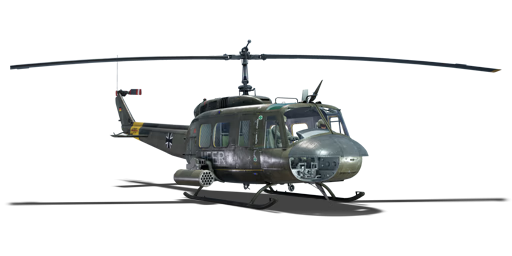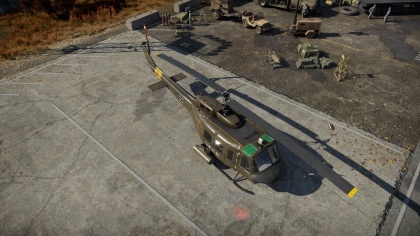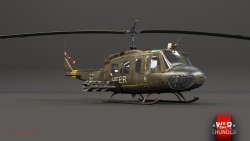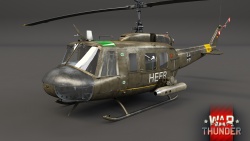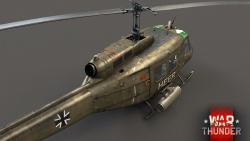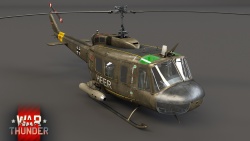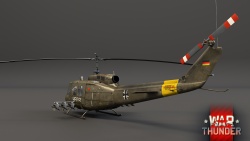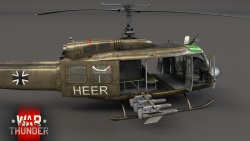UH-1D (Germany)
Contents
| This page is about the German utility helicopter UH-1D (Germany). For other uses, see UH-1 (Family). |
Description
The ◄UH-1D is a rank V German utility helicopter
with a battle rating of 9.0 (AB) and 8.7 (RB/SB). This helicopter was introduced in Update 1.83 "Masters of the Sea".
General info
Flight Performance
| Characteristics | |||
|---|---|---|---|
| Stock | |||
| Max Speed (km/h at ?,000 m) |
Max altitude (meters) | ||
| AB | RB | ||
| ? | ? | 5900 | |
| Upgraded | |||
| Max Speed (km/h at ?,000 m) |
Max altitude (meters) | ||
| AB | RB | ||
| ? | 287 | 5900 | |
Survivability and armour
Examine the survivability of the helicopter. Note how vulnerable the structure is and how secure the pilot is, how many engines the vehicle has. Describe the armour, if there is any, also mention the vulnerability of other critical aircraft systems.
Armaments
Suspended armament
Describe the helicopter's suspended armament: additional cannons under the winglets, any type of bombs, and rockets. Since any helicopter is essentially only a platform for suspended weaponry, this section is extremely important and deserves your special attention. If there is no suspended weaponry remove this subsection.
Usage in battles
Describe the tactics of playing in the helicopter, the features of using vehicles in a team and advice on tactics. Refrain from creating a "guide" - do not impose a single point of view but give the reader food for thought. Examine the most dangerous enemies and give recommendations on fighting them. If necessary, note the specifics of the game in different modes (AB, RB, SB).
Pros and cons
Pros:
- Able to carry 6 SS.11s ATGMs
- Able to carry unguided HEAT rockets with good penetration (which the predecessor Alouette II could not)
- Reasonably fast (Fastest in the Bell Huey helicopter family in WT with exception to the AH-1F/S and AH-1Z)
- Very wide ATGM camera gimbal limits (110 degrees to each side horizontally and +10 to -70 vertically)
- Light weight allows helicopter to glide reasonably well, for a helicopter (glide ratio 4:1, 15° below horizon)
- Joystick specific handling characteristics:
- Very low minimum stable flight speed
- Excellent yaw rate and stability
- Perhaps the easiest helicopter in the game to hover without SAS mode assistance
- Weak adverse roll (retreating blade stall effect) at high speeds
- Easier to recover from retreating blade stall compared to other helicopters
- Positive vertical ATGM camera limit allows the helicopter to hit targets slightly above the horizon while maintaining forward stable flight conditions
Cons:
- Has a moderate tendency to nose over into an inverted dive
- Low redline speed (160 knots, 295 km/h),
- Helicopter is rather fat and long, therefore easy to hit
- Cannot equip any guns together with missile/rockets and the only gun modification allowed is the fixed M134 Minigun pods
- Night vision is essentially useless
- No countermeasure flares
- Not a lot of armour
- Joystick specific handling characteristics:
- Lack of SAS modes
- Tends to float while flaring (pitching up to slow down) because the helicopter is very light and minimum collector lift is rather high compared to other helicopters
- Tends to bleed off RPM quickly if the flight angle of attacks is large
History
The United States Army identified in 1952 a need for a new general utility helicopter which could also serve as medical evacuation (MEDEVAC) and instrument training helicopter too. The current inventory of helicopters had several flaws which the Army wanted to overcome including being too large, underpowered or extremely complex to maintain. The Army wanted a workhorse that was easy to maintain and have a fairly small profile. Twenty companies participated in the bidding process and in 1955, Bell Helicopter was selected to build three copies of the Model 204 for evaluation, and this version was designated XH-40 (Experimental Helicopter-40).
The XH-40 was built with the Lycoming YT52-L-1 (LTC1B-1) turbo engine helicopter, the first non-piston helicopter tested by the military and first flew in 1956. Even before the prototype had flown, the Army put in an order for six YH-40 service test aircraft in which they could field test to determine how it would work under military unit operations. Proving successful, Bell was awarded a contract to build another 100 helicopters which were designated HU-1A (Helicopter Utility-1A) and hence was officially named Iroquois. Iroquois ended up being a mouthful for people to say, so a nickname developed from the HU-1 designation which ended up being pronounced as Huey and stuck. In September 1962, the Department of Defense changed up the aircraft identification system to streamline between all of the different aircraft and their variations and changed the HU-1 to UH-1 (Utility Helicopter-1). Even with the change, the official Army name and the new DOD designation was rarely used as Huey was so well recognised as the name, that is what was to most people.
Unfortunately, with all of the positive feedback received for the YH-40, service tests performed by the Army found the T53-L-1A engine was found to be underpowered and could not perform to the level that was needed. Bell proposed to swap the T53-L-1A engine with the T53-L-5 engine, upping the shaft horsepower from 770 to 960 (570 kW to 720 kW) and extended the cabin to accommodate more people, up to 7 passengers or four stretchers and a medical attendant. The first production of the new helicopter UH-1B was delivered for service in 1961.
Several aerodynamic deficiencies of an armed UH-1B was explicitly identified not having enough engine power to lift the necessary weapons systems. The UH-1C was developed to overcome these problems by upgrading the helicopter with the T53-L-11 engine which had 1,100 shaft horsepower or 820 kW. The UH-1B helicopters which were in the service of the Army at the time were also upgraded with the new engine. Several adjustments were made to the UH-1C which included a new rotor-system, however, like many things which are upgraded, domino effect also requires other components and modules also to be updated. A larger diameter rotor was installed to counter blade stall during dives which required the tail boom to be extended and larger synchronized elevators to be added. While operating in military operations, it was determined necessary to add a redundant hydraulic control system to allow for continued operation in the event of a failure in one system. Larger fuel tanks allowed for further range with the total useful load capacity topping out at 4,673 lbs (2,120 kg). Mid-1966 saw the line production of the fully upgraded UH-1C helicopter.
Huey model 204 helicopters were a huge success and were put to use in several different capacities. However, the Army wanted another version which facilitated the carrying of more troops which spawned the Model 205. Bell adjusted by extending the HU-1B’s fuselage by a total of 41 in (104 cm), boxed in the transmission and was able to add four more seats, two on each side of the transmission box facing out the side doors. With the side doors being easily removable, options to fly without doors made for quick loading and unloading of the helicopter which could now accommodate 15 persons, including the crew and could now hold six stretchers and a medic. First flown in 1961, the 205 took on many of the same upgrades as the UH-1C including the T53-L-11 which enabled usage of multiple types of fuel. Prototypes of this helicopter were designated YUH-1D, and the final assembly line aircraft was called the UH-1D.
This helicopter while still under evaluation the Army sent it to Vietnam in 1962 where it began operations. Initially only required as a general utility, MEDEVAC, and an instrument trainer, this helicopters role also expanded to include but not limited to air assault, cargo transport, search and rescue, electronic warfare and eventually ground attack.
During the Vietnam War, the UH-1 earned several other nicknames other than "Huey" which quickly identified to troops what role the helicopter had been outfitted for. Gunship versions of the UH-1s were identified as Frogs or Hogs if they carried rockets while if they just carried guns, they were identified as Cobras. Troop transport versions were called Slicks due to weapon pods being absent on the external pylons while they did retain their door gunners. Later in the war from 1967 to 1968, the gunship Huey’s were replaced by the new AH-1 attack helicopters.
The success of the Iroquois helicopters did not go unnoticed by allies of the United States. When the USA released the UH-1D model, the West German government agreed to purchase a license to manufacture the latest Iroquois helicopters at German factories, particularly those of the Dornier company. Between February 1967 and the end of 1981, German aircraft manufacturers constructed 352 UH-1D helicopters.
Media
See also
Links to the articles on the War Thunder Wiki that you think will be useful for the reader, for example:
- reference to the series of the aircraft;
- links to approximate analogues of other nations and research trees.
External links
| Bell Aircraft Corporation | |
|---|---|
| Aircraft | |
| Fighters | P-39N-0 · P-39Q-5 |
| P-400 | |
| P-63A-10 · P-63A-5 · P-63C-5 · ␠Kingcobra | |
| Jet Fighters | P-59A |
| Export | ▂P-39K-1 · ▂Pokryshkin's P-39N-0 · ▂P-39Q-15 · ▄P-39Q-25 |
| ▂P-63A-5 · ▂P-63A-10 · ▂P-63C-5 · ▄P-63C-5 | |
| Helicopters | |
| Attack | AH-1F · AH-1G · AH-1Z · AH-1W |
| OH-58D | |
| Utility | UH-1B · UH-1C · UH-1C XM-30 |
| Export/Licensed | ▅UH-1B · ◄UH-1D |
| Tzefa A · Tzefa B · Tzefa D/E · ▅AH-1S early · ▅AH-1S · ▅AH-1S Kisarazu · ␗AH-1W | |
| ␗OH-58D | |
| See Also | Fuji Heavy Industries · Agusta |
| Germany helicopters | |
|---|---|
| Attack | |
| Hip | ◊Mi-8TB |
| Hind | ◊Mi-24P · ◄Mi-24P HFS 80 |
| Tiger | EC-665 Tiger UHT |
| Utility | |
| BO 105 | BO 105 CB-2 · BO 105 PAH-1 · BO 105 PAH-1A1 |
| Alouette | ◄SA 313B Alouette II |
| Huey | ◄UH-1D |


